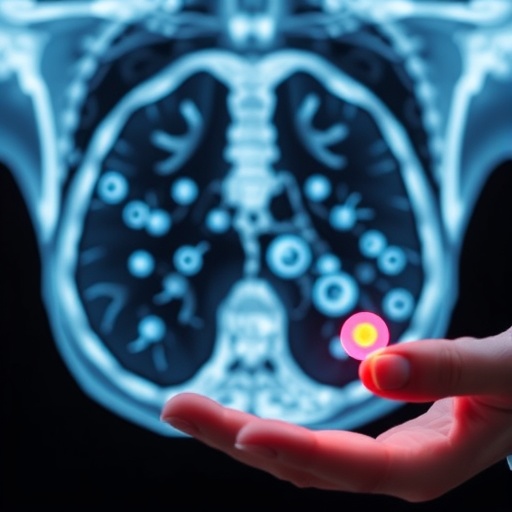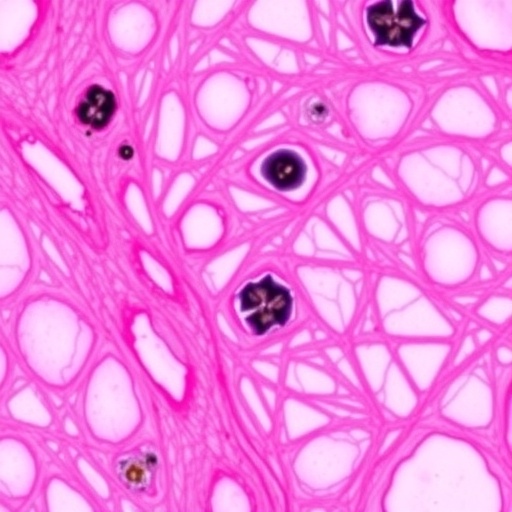In a groundbreaking study that has the potential to revolutionize early prostate cancer detection, researchers at Uppsala University have harnessed the power of artificial intelligence (AI) to identify subtle morphological changes in tissue samples that are imperceptible to the human eye. This pioneering work delves into the intricate microarchitectural alterations present in prostate biopsies initially classified as benign, revealing that these early, overlooked signals may foreshadow the subsequent development of aggressive cancer. The implications for clinical practice and patient prognosis are profound, suggesting a paradigm shift in how histopathological assessments are conducted.
Traditional prostate cancer diagnostics rely heavily on pathologists’ ability to interpret tissue biopsies under the microscope, a process that, despite its rigor, is subject to human limitations. The study, spearheaded by Carolina Wählby, Professor of Quantitative Microscopy at Uppsala University’s Department of Information Technology and SciLifeLab, demonstrates that AI can augment and surpass the sensitivity of experienced pathologists. By meticulously analyzing thousands of small regions within biopsy images, the AI algorithm was trained to detect complex and nuanced tissue patterns indicative of oncogenic transformation long before they become visually obvious.
One of the study’s most striking revelations is that more than eighty percent of men whose prostate biopsies were initially deemed healthy by expert pathologists showed subtle yet diagnostically relevant changes when analyzed by AI. These men were part of a cohort of 232 individuals who had been followed longitudinally, with half developing clinically aggressive prostate cancer within two and a half years, while the others remained cancer-free for at least eight years. This longitudinal aspect provides compelling evidence that the morphological cues identified by AI are not random artifacts but genuine precursors to malignant progression.
.adsslot_AXKQOHvzoL{width:728px !important;height:90px !important;}
@media(max-width:1199px){ .adsslot_AXKQOHvzoL{width:468px !important;height:60px !important;}
}
@media(max-width:767px){ .adsslot_AXKQOHvzoL{width:320px !important;height:50px !important;}
}
ADVERTISEMENT
The technical approach embraced in this research leverages advanced imaging analysis on digitized histological slides. Unlike conventional methods that examine biopsies mostly as entire global samples, the AI systematically evaluates the tissue in small, interrelated segments, honing in on subtle glandular and stromal abnormalities. This granular level of inspection enables the detection of microenvironmental changes—such as alterations in gland architecture and surrounding connective tissue—that have been associated with early tumorigenesis but remain below the resolution of standard diagnostic criteria.
Building the AI model required a novel training strategy due to the inherent challenge of having only negative-labeled samples at baseline. The researchers circumvented this by adopting a weakly supervised learning framework, inferring that biopsy specimens from patients who later developed prostate cancer must harbor microscopic clues. Through this clever methodological innovation, the algorithm gradually learned to distinguish between benign and potentially malignant tissue patterns, despite the absence of explicit annotations marking the exact location of cancerous changes at the initial biopsy.
Furthermore, when the algorithm’s findings were interrogated, it highlighted tissue abnormalities consistently located around the prostate glandular regions, a discovery paralleling insights from prior molecular and morphological studies. These areas showed modifications that might precede cellular atypia or invasive carcinoma, including subtle variations in gland shape, epithelial-stromal interactions, and extracellular matrix remodeling. Such detailed tissue phenotyping through AI heralds a new era in precision pathology, where the microenvironmental context is integrated into cancer risk assessment.
The clinical significance of this study cannot be overstated. Currently, men with negative biopsy results often face uncertainty regarding their cancer risk and appropriate follow-up intervals. The AI-powered diagnostic tool offers a quantitative and objective measure to stratify patients according to their true risk profile, enabling earlier interventions and personalized monitoring schedules. By discerning which individuals are most likely to harbor occult neoplastic changes, the health care system can optimize resources and improve patient outcomes through timely therapeutic strategies.
Importantly, the multidisciplinary collaboration between Uppsala University and Umeå University facilitated the assembly of a robust and diverse dataset of tissue samples, enhancing the generalizability of the AI model. Data transparency and accessibility were prioritized, as the imaging datasets and analytical workflows have been made openly available to propel further research and refinement in this promising domain. Open science practices like these are integral to accelerating innovations bridging computer science and pathology.
While the promise of AI in medical diagnostics has been widely recognized, this study marks a concrete demonstration of its ability to detect molecularly silent yet morphologically indicative changes within ostensibly normal tissues. It paves the way for integrating AI as a complementary diagnostic modality alongside pathologists, aiming to reduce missed diagnoses and improve the predictive power of histopathological evaluations. The findings invite a reevaluation of diagnostic thresholds and call for clinical trials to validate AI-driven decision-making frameworks in routine prostate cancer screening.
Carolina Wählby and her team emphasize that their work is a stepping stone toward deploying AI tools that fundamentally rethink cancer detection—not by replacing human expertise, but by extending it. They advocate for a future where routine biopsies undergo dual scrutiny: traditional pathological examination followed by AI-powered imaging analysis, thereby drastically reducing the window in which aggressive prostate cancers remain undetected. This dual approach could transform prognosis and survival for thousands of men worldwide.
In conclusion, the discovery of tumor-indicating morphological changes in benign prostate biopsies through AI signals a new frontier in oncological diagnostics. It merges cutting-edge quantitative microscopy, sophisticated computational analysis, and clinical expertise to reveal the invisible signatures of cancer at its nascent stage. As this technology matures and integrates into healthcare workflows, it may redefine early cancer detection, enabling timely and targeted interventions that save lives.
Subject of Research: Human tissue samples
Article Title: Discovery of tumour indicating morphological changes in benign prostate biopsies through AI
News Publication Date: 21-Aug-2025
Web References: http://dx.doi.org/10.1038/s41598-025-15105-6
Image Credits: Mikael Wallerstedt
Keywords: Prostate cancer, Artificial intelligence, Histopathology, Digital microscopy, Tissue imaging, Early cancer detection, Quantitative morphology, AI diagnostics
Tags: AI in cancer detectionartificial intelligence in pathologyearly cancer detection techniquesenhancing pathologist accuracyhistopathological assessment improvementsmachine learning in healthcaremorphological changes in tissue samplesoncogenic transformation indicatorsprostate biopsy analysisprostate cancer diagnosticsrevolutionizing cancer screening methodsUppsala University research





